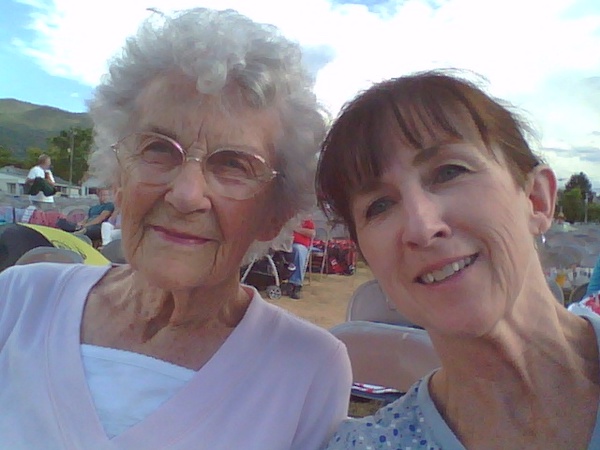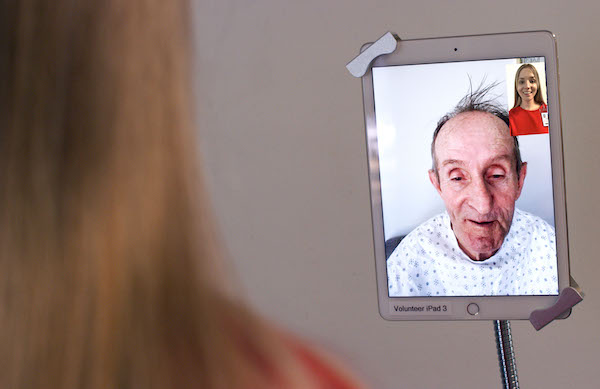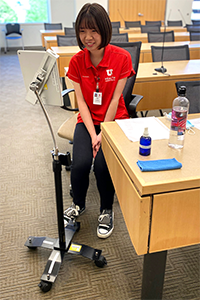
Author: Kylene Metzger
When her mother was loaded into an ambulance and rushed to University of Utah Hospital, fear took over Colleen Hansen. “It was scary with someone at that age not being able to be with her,” Hansen said.
It was the Sunday before Memorial Day and the number of COVID-19 cases in Utah was on the brink of rising. The day was ordinary for 98-year-old Aase Strand. She was getting ready in the bedroom of her apartment when she fell down. Strand had fallen before, but this one was more serious.

Doctors at University of Utah Health determined Strand fractured her femur and needed surgery. She was admitted to University Hospital for five days. “People were in masks, and she didn’t know who they were,” Hansen said. “She was trying to get her wits about where she was at.” Hospital staff identified Strand as a good candidate for the Geriatrics Hospital Elder Life Program, or HELP.
HELP is a structured, evidence-based, patient care program designed to prevent delirium while reducing cognitive and functional decline in hospitalized older adults. “Delirium is a very common complication that affects older people in the hospital,” said Mark Supiano, MD, chief of the Division of Geriatrics at U of U Health. “When it develops, it’s hard to treat and is associated with very high morbidity and mortality outcomes.”
Specially trained volunteers assist hospitalized older adult patients enrolled in HELP by maintaining cognitive, physical, and emotional well-being while providing comfort during the patients’ hospital stay. That makes it easier for them return home at their maximal level of independence. “HELP volunteers are a key component of the program in delivering intervention that’s been proven to prevent delirium,” Supiano said.
“HELP volunteers are a key component of the program in delivering intervention that’s been proven to prevent delirium.”
Mark Supiano, MD, chief of the Division of Geriatrics at U of U Health
However, the COVID-19 pandemic quickly changed the way HELP volunteers interacted with patients. The program was one of the first to be affected by new restrictions placed on visitors to keep those inside the hospital safe from the transmission of COVID-19. Yet the isolation that patients like Strand were experiencing—along with those being treated for COVID-19 and others at high delirium risk—required a response.
The change meant volunteers could no longer interact with patients in person. “We quickly had to come up with an alternative strategy to connect patients to HELP volunteers,” Supiano said. When patient appointments were moved virtually across the U of U Health system, HELP staff came up with their own virtual format using iPads. When Cameron Tingey, chief customer officer of CaptionCall, learned of the need for devices for older adult patients, the company sprang into action and donated 30 new iPads to the program. “HELP patients are our patient population,” Tingey said. “The goal of the donation was to improve patient welfare by counteracting loneliness, isolation, and delirium.”
Before the COVID-19 pandemic, older adult patients would be screened in person and undergo a cognitive assessment. Patients would then be enrolled in HELP and assigned a volunteer who would visit the patient in their room three times a day.
Transitioning HELP to the virtual world took on a whole new meaning. It began with depending on nurses, therapists, and other hospital staff. “We had to figure out how to get the iPads in the hands of patients,” said Mimi Beattie, DNP, and elder life nurse specialist. “The HELP program partnered with nursing and physical therapy to check out an iPad to the patient and inform the HELP program.” Physical therapists also teach patients who don’t know how to use an iPad so they can navigate through different apps.

HELP volunteers, mostly made up of pre-professional students such as nurses, doctors, and physical assistants, virtually adapted some of their daily patient protocols. Instead of encouraging a patient to get out of bed and walk the hospital hallways, volunteers transitioned to leading a series of range-of-motion exercises through the iPad. Other protocols have been modified based on patient requests. “One COVID-19 patient asked a volunteer to show them what it looked like outside, so now we’ve added that to the protocol,” said Alijana Kahriman, MS, elder life specialist for HELP.
The iPads have also connected patients to their families and friends, which Hansen describes as a “life-saver” for her family. “I can’t explain the very first time I saw her on the iPad,” Hansen said about her mother. “It was just overwhelming and emotional.” Seeing the recognition in her mother’s face made her realize that connecting through the iPad was working. “Patients are so isolated right now,” Kahriman said. “Sometimes we’re the only non-clinical conversation they are receiving”.
The iPads, specifically tailored for the user experience of older adults, have now been deployed across hospital units and ICUs. Besides phone and video calls, the iPads offer a number of interactive games to keep HELP patients mentally engaged and stimulated. “A number of apps help achieve the same goals of the Elder Life Program, which is to keep patients engaged and minimize the social isolation they may be feeling,” Supiano said. Patients also have the option to listen to music, read the newspaper, and practice simple range-of-motion exercises.

As the COVID-19 pandemic evolves (and hopefully dissipates), Supiano said the iPads will continue to be put in good use. Patients who once could not be enrolled in HELP because of contact precautions can now use iPads to connect to volunteers and their families. Out-of-state patients or patients who don’t have their own device can also use the iPads to reach their loved ones.
Strand, a grandmother of 12, is now recovering in a local rehabilitation facility. Her family is thankful for the HELP staff, which Hansen said gave them hope during an uncontrollable situation. “I had to face the reality that my mom may or may not make it,” Hansen said, “and not having communication was the hardest part of it all. Had she not been able to connect with myself or sister at some point, I think she would have just given up.”